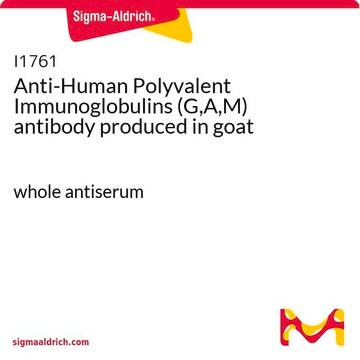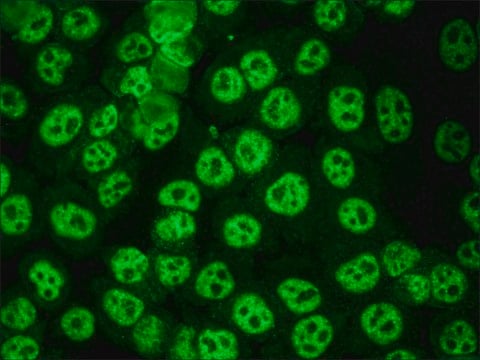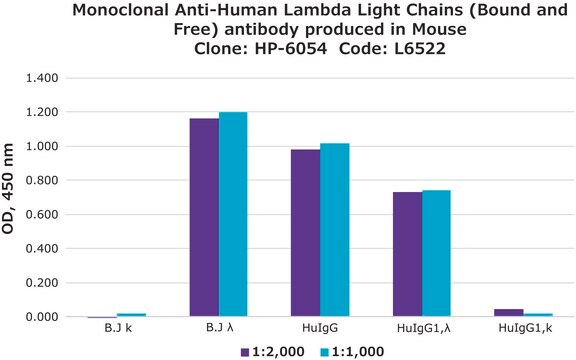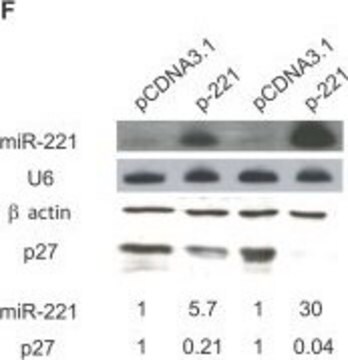I8010
Anti-Human Polyvalent Immunoglobulins (G,A,M) antibody produced in rabbit
whole antiserum
Se connecterpour consulter vos tarifs contractuels et ceux de votre entreprise/organisme
About This Item
Produits recommandés
Source biologique
rabbit
Niveau de qualité
Conjugué
unconjugated
Forme d'anticorps
whole antiserum
Type de produit anticorps
secondary antibodies
Clone
polyclonal
Contient
15 mM sodium azide
Technique(s)
immunoelectrophoresis: suitable
Conditions d'expédition
dry ice
Température de stockage
−20°C
Modification post-traductionnelle de la cible
unmodified
Catégories apparentées
Description générale
Immunoglobulin G (IgG) belongs to the immunoglobulin family and is a widely expressed serum antibody. IgG is usually found as a monomer. IgG antibody subtype is the most abundant of serum immunoglobulins of the immune system. About 70 percent of the total immunoglobulin consists of IgG. Immunoglobulin M (IgM ) is a high molecular weight protein that has five or six subunits. It is the first immunoglobulin produced by neonates.
Application
Anti-Human Polyvalent Immunoglobulins (G,A,M) antibody produced in rabbit has been used in enzyme-linked immunosorbent assay (ELISA) and sandwich ELISA.
Anti-Human Polyvalent Immunoglobulins (G,A,M) antibody produced in rabbit was used in sandwich ELISA as a standard.
Actions biochimiques/physiologiques
IgG antibody subtype is the most abundant of serum immunoglobulins of the immune system. It is secreted by B cells and is found in blood and extracellular fluids and provides protection from infections caused by bacteria, fungi and viruses. Maternal IgG is transferred to fetus through the placenta that is vital for immune defence of the neonate against infections. IgA antibody is secretory antibody and is present abundantly in mucous linings of gastrointestinal, respiratory and genitourinary tracts, tears and saliva. IgM antibodies are present as pentamers in the serum and are produced in response to antigens.
Immunoglobulin M (IgM) acts as an antigen specific part of the B cell antigen receptor on the surface of B lymphocytes that are not stimulated, in its monomeric form. Polymeric IgM molecules also serve as important activators of the classical complement cascade. IgM is essential in agglutination and cytolytic reactions. Immunoglobulin G (IgG) participates in hypersensitivity type II and type III.
Clause de non-responsabilité
Unless otherwise stated in our catalog or other company documentation accompanying the product(s), our products are intended for research use only and are not to be used for any other purpose, which includes but is not limited to, unauthorized commercial uses, in vitro diagnostic uses, ex vivo or in vivo therapeutic uses or any type of consumption or application to humans or animals.
Vous ne trouvez pas le bon produit ?
Essayez notre Outil de sélection de produits.
Code de la classe de stockage
10 - Combustible liquids
Classe de danger pour l'eau (WGK)
nwg
Point d'éclair (°F)
Not applicable
Point d'éclair (°C)
Not applicable
Faites votre choix parmi les versions les plus récentes :
Déjà en possession de ce produit ?
Retrouvez la documentation relative aux produits que vous avez récemment achetés dans la Bibliothèque de documents.
The severe combined immunodeficient-human peripheral blood stem cell (SCID-huPBSC) mouse: a xenotransplant model for huPBSC-initiated hematopoiesis
Goan SR, et al.
Blood, 86(1), 89-100 (1995)
Molecular Genetics of Immunoglobulin, 17, 575-586 (1987)
The Immunoglobulins: Structure and Function, 1-26 (1998)
C G Bridges et al.
Antimicrobial agents and chemotherapy, 40(5), 1072-1077 (1996-05-01)
The novel acyclonucleotide derivative of guanine, 9-[2-methylidene-3-(phosphonomethoxy)propyl] guanine (MDL 74,968), had antiviral activity comparable to those of 9-(2-phosphonomethoxyethyl) adenine (PMEA) and 2',3'-dideoxyinosine against laboratory strains of both human immunodeficiency virus (HIV) types 1 and 2 cultured in MT-4 cells and
MDL 74,968, a new acyclonucleotide analog: activity against human immunodeficiency virus in vitro and in the hu-PBL-SCID. beige mouse model of infection.
Bridges CG, et al.
Antimicrobial Agents and Chemotherapy, 40(5), 1072-1077 (1996)
Notre équipe de scientifiques dispose d'une expérience dans tous les secteurs de la recherche, notamment en sciences de la vie, science des matériaux, synthèse chimique, chromatographie, analyse et dans de nombreux autres domaines..
Contacter notre Service technique








